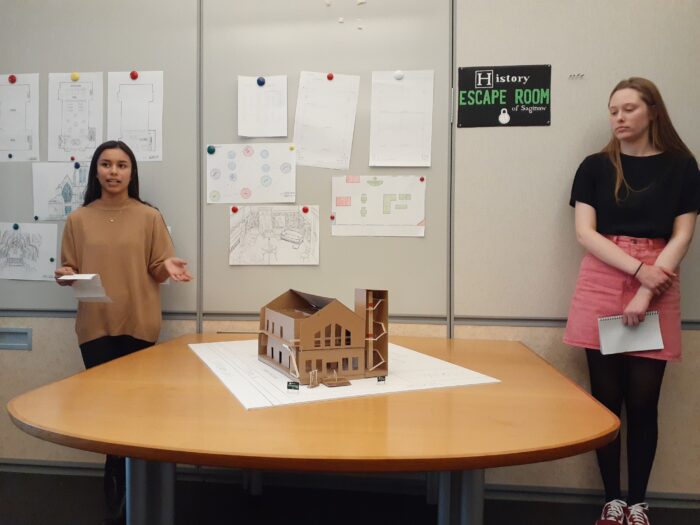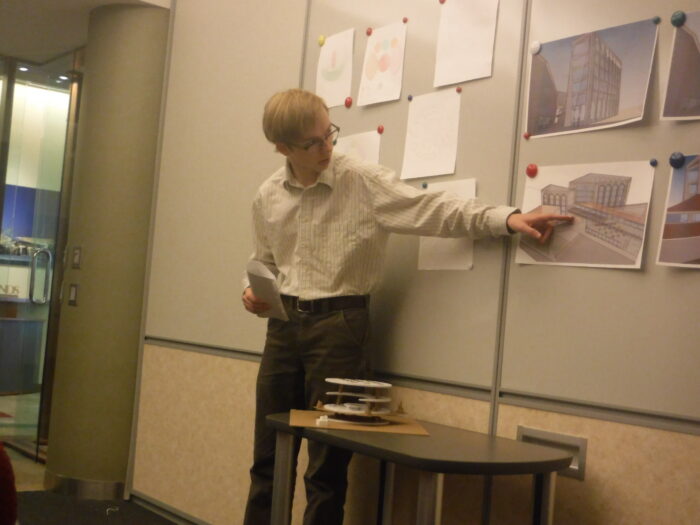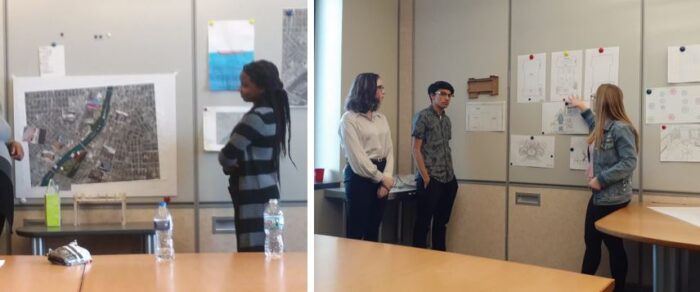


With retiring architects outpacing those entering the profession, the cost of college escalating, and no architecture schools located within 100 miles of the Saginaw Valley Region, architect Erin Andrus, AIA, saw opportunity. She developed [Re]Design Saginaw, a free program to expose local high school and community college students to the field of architecture, and help students realize their potential in hopes they might return to the region after college as professionals to positively impact their community.
 [Re]Design Saginaw, facilitated by Erin with support from the AIA Saginaw Valley section and her employer, WTA Architects, first began in 2017. The ‘externship’ program is conducted as a week-long, in-person workshop from 3-7 p.m., typically in early March (with the exception of this year’s program, which will be virtual. Last year, the program took place March 2-6, 2020, right before COVID). The program is open to all interested area high school and Delta College students. [Re]Design Saginaw has received MAF Architecture Awareness Grants annually since its inception, to help fund the cost of program supplies.
[Re]Design Saginaw, facilitated by Erin with support from the AIA Saginaw Valley section and her employer, WTA Architects, first began in 2017. The ‘externship’ program is conducted as a week-long, in-person workshop from 3-7 p.m., typically in early March (with the exception of this year’s program, which will be virtual. Last year, the program took place March 2-6, 2020, right before COVID). The program is open to all interested area high school and Delta College students. [Re]Design Saginaw has received MAF Architecture Awareness Grants annually since its inception, to help fund the cost of program supplies.
“The primary goal of the program is to get local students interested in becoming licensed architects,” said Erin, a senior associate at WTA and current AIA Saginaw Valley president. “With no architecture programs in the area, moving away to attend architecture school can be expensive. Beyond the rigorous education requirements, the internship and examination process can be intimidating as well. We also wanted to expose students to the idea that as architects, they can make a positive impact in their Saginaw Valley hometowns, and not feel they are missing out by not living in a larger metropolis.”
 [Re]Design Saginaw participants work in small groups and are given a design challenge, including re-imagining an under-utilized lot or vacant building, such as an abandoned church. “On day one, students learn about site planning,” said Erin. “If the site is close, we walk to see it in person. It’s an important place to start, since we want them to observe the site in relation to its surroundings, and determine how that impacts their project. Throughout the program, our goal is to push students to envision how occupants might use and experience those spaces, and develop creative solutions through programming and design.”
[Re]Design Saginaw participants work in small groups and are given a design challenge, including re-imagining an under-utilized lot or vacant building, such as an abandoned church. “On day one, students learn about site planning,” said Erin. “If the site is close, we walk to see it in person. It’s an important place to start, since we want them to observe the site in relation to its surroundings, and determine how that impacts their project. Throughout the program, our goal is to push students to envision how occupants might use and experience those spaces, and develop creative solutions through programming and design.”
The program takes place at WTA’s Saginaw office over a week, mimicking an architecture school design studio atmosphere. Students learn how to present their design ideas and are challenged to think broadly, and are mentored daily by WTA’s architects via critiques, as they would in architecture school. Students also hear from a recent architecture school graduate regarding their experiences in architecture school and in entering the profession. The week concludes with students presenting their projects to one another, AIA Saginaw Valley members, and their teachers and parents. WTA supplies snacks for students throughout the week, and the AIA Saginaw Valley section pays for a pizza party prior to final presentations on the last day.
 This year’s participants will meet and receive instruction virtually, but mostly complete coursework independently. Each student will design a pocket park for a vacant lot within the city limits, knitted together with the work of their teammates by a theme of their choosing, such as a color, history, or even famous athletes from Saginaw. The virtual format will provide the same activities and presentations as the live program. “The pocket park idea was presented by Saginaw Future Business Development Manager Cassie Miller, who is an urban planner by trade,” said Erin. “We are always looking for good project partners and groups to work with and for inspiration, as Cassie provided. We’re excited to see the ideas our students will generate, and for the potential that the Saginaw Future may want to utilize some of them.”
This year’s participants will meet and receive instruction virtually, but mostly complete coursework independently. Each student will design a pocket park for a vacant lot within the city limits, knitted together with the work of their teammates by a theme of their choosing, such as a color, history, or even famous athletes from Saginaw. The virtual format will provide the same activities and presentations as the live program. “The pocket park idea was presented by Saginaw Future Business Development Manager Cassie Miller, who is an urban planner by trade,” said Erin. “We are always looking for good project partners and groups to work with and for inspiration, as Cassie provided. We’re excited to see the ideas our students will generate, and for the potential that the Saginaw Future may want to utilize some of them.”
As years pass, Erin is seeing more students already interested in becoming architects registering for [Re]Design Saginaw. “Several past participants have contacted us about college applications or with questions about the different architecture schools in the state. A few of them are enrolled in architecture school, and have contacted us about summer internships, or to be advisors for their high school senior projects. I have even personally reviewed and critiqued a couple of architecture student portfolios, and written a couple of recommendation letters. We really want to see our local talent succeed.”
[Re]Design Saginaw also supports MAF mission to advance awareness of how architecture enriches life. Said Erin, “Our goal is to help students understand how architecture facilitates life, and defines the places that positively impact the lives of their friends, family and neighbors. We want students to dream big, become passionate about the profession, and instill pride in their community, in the hope they will return to help shape the future of the Saginaw Valley.”
